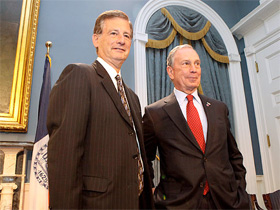Memo to Goldsmith: To Balance NYC’s Transpo System, Make Cycling Safer
 Deputy Mayor Stephen Goldsmith and Mayor Bloomberg. Photo: Daily News
Deputy Mayor Stephen Goldsmith and Mayor Bloomberg. Photo: Daily NewsThere’s a lot to like about Stephen Goldsmith’s answers during yesterday’s must-read interview with WNYC’s Andrea Bernstein. It’s clear that NYC’s new deputy mayor for operations has a passion for efficiency. He comes across as deeply attuned to the fact that we allocate much of our scarce street space in a grossly inefficient way — whether by giving motorists a free ride during the most congested times of day, or by letting space-hogging single occupant vehicles have the same priority as buses full of people.
Here’s a highlight from his take on Select Bus Service on the East Side:
I think the way we should look at this is how New Yorkers can move most
efficiently at the lowest cost, going where they want to go –- to shop, or
to entertainment, or to work. And express bus lanes are definitely an
important element of that. They are a way to move lots of people more
efficiently and less expensively than other ways. And to the extent
that we can shorten the travel times of those buses will be in
everybody’s best interests.
But Goldsmith is more tentative when it comes to another spatially efficient mode — the bicycle:
There are differences in opinion about bikes. The transportation
director is a very creative woman. She has lots of ideas and those
ideas make the city a very exciting place but many of those ideas are
also controversial and I think the program for bikes is a good one. I
also understand that those policies can literally and figuratively
collide with automobiles and transportation policy. I know the mayor is
interested in getting the balance right and so I salute a director who
has a lot of innovative ideas and also understand that we need to
balance those against the interests of others and see what happens.
Let’s assume that Goldsmith’s separation of bike policy from transportation policy is a rhetorical slip-up. (Later on, he gives Bernstein his thoughts on bike-share as a solution to a transportation problem: "A lot of New Yorkers travel short distances and if we can help them
travel short distances in a safe way then it should be considered but
it’s not without challenges.") Even so, it’s notable that the question of "balance" only seems to arise when the subject is bicycling.
"Balance" in this case makes sense mainly on a political level. (Goldsmith tells Bernstein that he and the mayor want to avoid "ancillary
byproduct problems" — read into that phrase what you will.) In terms of transportation policy and allocation of the street, bike improvements are attempts to restore balance and bust up the spatial monopoly of motorized modes. In Manhattan, especially north of 34th Street, there’s not much balance on wide avenues. On First and Second, where plans for separated bikeways face continued uncertainty uptown, there’s no protected space for cycling, even in neighborhoods that are demanding it.
Goldsmith doesn’t seem to be sold yet on the way bike infrastructure fits into a lean, efficient, low-cost transportation system. But the potential to promote cycling — improving public health and safety, reducing traffic, and putting less wear and tear on our roads — is substantial and cuts across every borough. According to a recent study from the Department of City Planning, most workers in Brooklyn, Queens, the Bronx, and Staten Island commute within the same borough — they’re not making long trips. But a majority of those workers arrive by car. (We’ll have more on that study soon.)
A robust commitment to cycling should be of a piece with Goldsmith’s commitment to use public resources efficiently. Better bikeways make sense for many of the same reasons that busways appeal to him. Thus, we present this re-mix:
I think the way we should look at this is how New Yorkers can move most
efficiently at the lowest cost, going where they want to go –- to shop, or
to entertainment, or to work. And safe, convenient bike routes are definitely an
important element of that. They are a way to move lots of people more
efficiently and less expensively than other ways. And to the extent
that we can improve the safety and convenience of those bike trips will be in
everybody’s best interests.